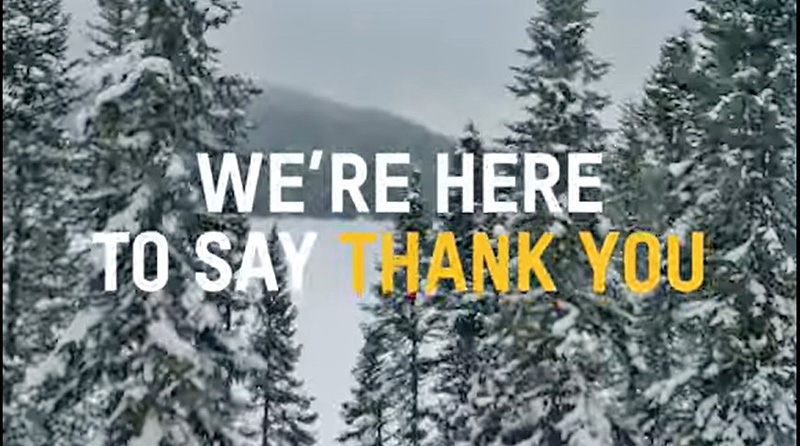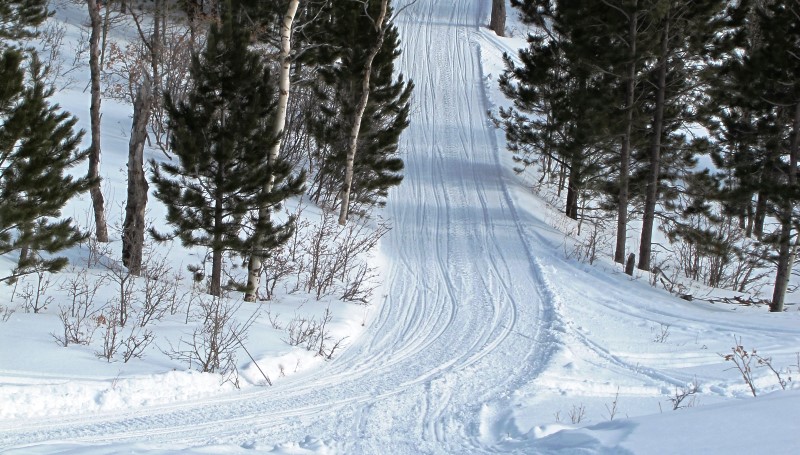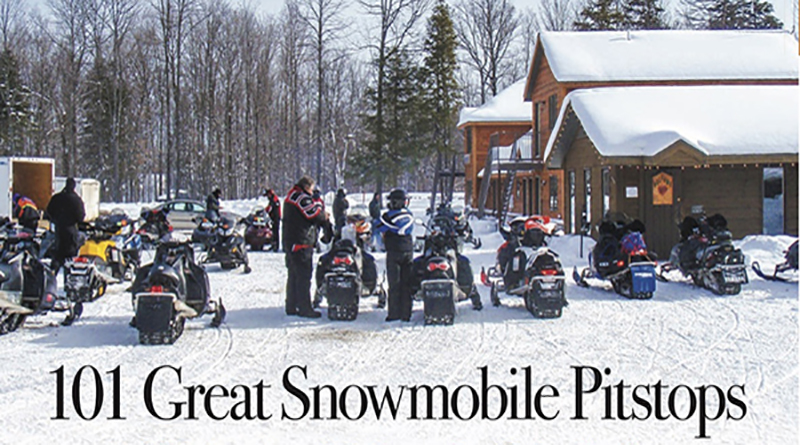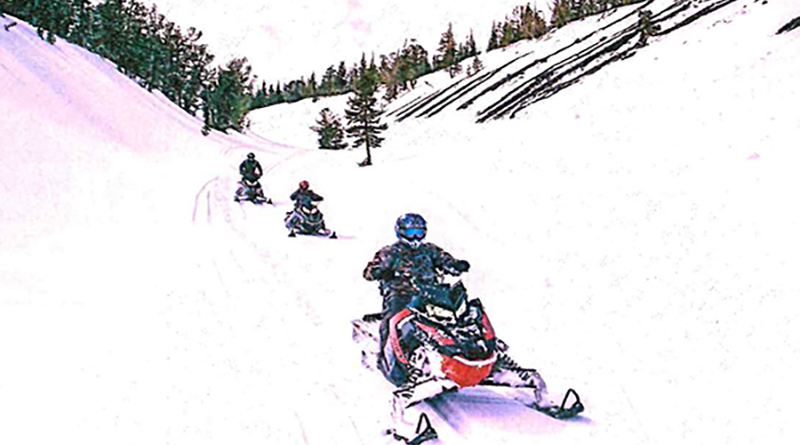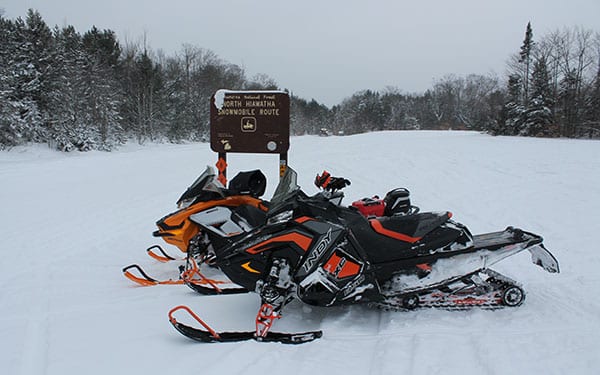He shakes his head, looks down and kicks the snow with his boot.
“Today, I am not proud of my trails,” he says, as he looks up to survey the long, straight stretch of mildly rippled white ribbon.
We were heading toward Lake Joncas on the second day of a four-day, high-mile blitz of the western side of the province. Marchand and his wife, Nancy, are übersnowmobilers who are involved in everything from trail patrol to grooming to tourism. Today, Marchand was guiding us through a particularly remote area through the Verendrye nature reserve. Nancy played sweep.
For any seasoned Midwestern rider, the small amount of chatter we felt would be something we’d say “makes the trail interesting.”
To Marchand, it’s a disgrace for him, the Oursblanc Snowmobile Club and the Outaouais tourist region to allow anyone on less-than-perfect trails. Then again, Marchand has fired groomer operators for driving more than 5 mph on his trail system. “It just cuts off the top of the bumps,” he said, rather than smoothing the whole trail.
That doesn’t mean that all Quebec trails are tabletop smooth, but most are. We would even put Marchand’s trails in the “smooth” category, even if he didn’t.
A Quebec experience should be on every snowmobiler’s list of places to ride before they hang up the helmet, just like a trip to Yellowstone or riding in Alaska.
The Quebec standard for just about anything snowmobile-related is a step or two above anywhere else that caters to riders. A well-maintained network of trails is just the beginning. There are ample gas stops, numerous food-serving clubhouses called “relais,” extraordinary dining options and it becomes somewhat exotic with the French accent. Plus, there’s reliable snow in the province, especially when the sleds point north.
Quebec snowmobilers are also different than the average trail rider. Sled accessories that would seem tacky elsewhere — such as sheepskin seat covers — are common in Quebec. More people ride 2-Up than anywhere else, which we figure is partly due to the booming rental market, partly due to the smooth trails. Visitors and locals ride in Quebec for long-distance touring, not hotshot trail gunning.
So, when in Quebec, do like the Quebecois, which is why we took in 700 miles of trails in four days.
As guests of Tourism Quebec, we knew that there was a bit of an agenda to our ride: They’re looking for new markets to tap, and they have their eye on the U.S. Midwest. If you’re from Michigan, in particular, Quebec wants you.
So far, there have not been many of Michiganders in Quebec, or at least trailering machines there. In 2003-04, there was a reported 125 trail permits sold to Michigan residents, which pales in comparison to Quebec’s biggest U.S. target: New York. Last year, New Yorkers accounted for 3,061 trail permit sales. Of course, that’s not counting folks from Michigan or New York who went to Quebec and rented: they’re a little more difficult to track.
That’s why our main destination was the western edge of the province. Not only is it closer to Michigan, but it’s a relatively unexplored area of the province. Its proximity to Ontario means more English-speakers. It’s a more gentle approach to the sometimes confusing, often amusing world of cross-cultural communication.
This trip was also a swan song for the retiring Guy Tiffault, who has headed up Tourism Quebec’s snowmobile promotion — and a baptism for his replacement Daniel Larocque. On his first-ever snowmobile ride, Larocque rode a 170-mile day in extremely icy conditions, and was still rearing to go on day two. We think he’ll manage the job quite nicely.
Quebec divides itself into tourist regions, each with its own tourism promotions and offices. Together, they’re all promoting Quebec; internally, there’s informal competition to get tourists to their respective area. We crossed three tourist regions, each with its own unique approach to snowmobilers.
Take the northern Abitibi-Témi-scamingue area — visitors may not be able to pronounce its name, but one call to the tourist office will set up potential visitors with a complete itinerary. Other areas print glossy brochures, plan elaborate winter festivals or keep information flowing on numerous wintertime activities.
From Playground To Parkland
When looking at a snowmobile trail map of Quebec, there’s a large, dense concentration of trails on the south and north shores of the St. Lawrence Seaway. Scan east and north, and the trails thin out and the region becomes decidedly more remote.
We covered all spectrums of habitation, starting at Hotel L’Esterel in St. Marguerite-Esterel. This area is a popular get-away area for the Montreal well-to-do — we ogled at their expansive cabins from the laketop snowmobile trails.
It’s easy to see why it’s a popular playground: It’s only a bit more than an hour from Montreal, and the snow-covered rolling foothills make a cozy backdrop. The trails in this area twist and turn, with many elevation changes. We also found them to be quite icy and rough — quite contrary to every other ride we’ve had in Quebec — mostly due to a freeze-thaw-freeze cycle that had not yet received a fresh layer of snow. Suffice to say, it was a long, slow day and considering the slick corners and icy hills, we felt fortunate that no one went trackside up.
By the time we were about 40 miles from our destination, Maniwaki, it was cold and dark. The fatigue of the long day was taking its toll, and some in the group opted to take the sag wagon the remainder of the distance. Personally, I would have been content hanging out in the local dealership/gas station and drinking hot chocolate. I was tired and chilled.
The trailer couldn’t haul everyone, and I don’t like appearing like a wimp. So with all my gumption, I pulled the recoil and continued on with our diminished group.
We were rewarded for our perseverance. By this time a light snow was falling, and an unbelievable peace surrounded us as we continued on to Maniwaki. The fresh snow gave us confidence to pick up the pace, and we were refreshed upon our arrival to the Chateau Logue. At the end of the trip, those of us who did that extra mileage all agreed it was the highlight of the trip. It wasn’t so much the scenery — we could only see as far as our own headlights — it was the solitude, the snow and the feeling of control over our own destiny.
As we headed north the following day, with the Marchands, the scenery changed again. Gone were the tight, hilly trails of the south: The farther north we rode, the more rolling and forested the land became. The trails became wider and straightened out a bit. It also became increasingly remote. Remember the large blank areas on the map? We were riding through it. This area is not only nearly trail-less, it’s practically roadless.
Save a few outpost relais that sell food and fuel, there’s really not much there. The Marchands tell of relais workers so lonely,
they talk nonstop to any snowmobilers. A Francophone woman at a relais talked to me for at least five minutes before realizing that I really couldn’t understand her. I’m sure the stories were funny, as she was an animated storyteller — I just missed about 98 percent of the details.
A note to people who studied French in high school: the accent of Quebec French is a whole different ballgame and I wish you bon chance in understanding anything but the extreme basics. I suspect it’s akin to someone who learned English in rural Alabama trying to communicate with someone from the Scottish Highlands.
We took the main trail through the Verendrye nature reserve, and hardly met another sled. I’d like to say that we saw tremendous amounts of wildlife, but we didn’t. There was plenty of snow, though, and despite Marchand’s embarrassment, the trail was actually in great shape.
We arrived at Joncas Adventure hotel after sunset, and after riding more than 100 miles hardly seeing another soul, it was a great surprise to see a well-lit, lovely lodge appear in the dark. Sleds lined up outside indicated that a lot of riders were here, even though the empty trails said otherwise.
As with all places we stayed, there was some sort of attached dining establishment at Joncas. Food is taken more seriously here than anywhere else in Canada. A meal is an event, not a necessity. Food is tasty and well-presented. Expect a multi-course evening meal at any restaurant, and don’t expect quick service. There are set-price, multi-course meal deals at most places, should you not want to choose à là carte off the menu. Be adventurous and try local specialities, such as wild game patés or anything with maple syrup.
The following morning we continued farther north, the terrain turned more farm-like. There were still stands of trees, but more and more it became open fields and rural towns. Just outside the tiny town of Moffet, Luc and Nicole Richards run a homey resort called Driftwood.
Nicole manages the kitchen — using recipe cards inherited from her mom — and Luc does the maintenance and guiding. They used a government grant to construct energy-efficient guest cabins. The cabins appear to be log, but it’s actually log siding built on a foam core. Luc did the design and building; Nicole did the impeccable, themed interior design. A local woodcarver designed murals in each door.
The closer we traveled to the Ontario border, the more English-speaking it became. When we entered the small Indian town of Winneway, the street signs were suddenly in English. Larocque explained that these reservation towns spoke the language of the missionaries: the Catholic missionaries spoke French; the protestant spoke English.
Signs returned to French, though, at our final destination, the gold mining town of Val d’Or. This town had the most bustle we’d seen since we’d started the trip. The hotel was clean and fine, but it just wasn’t as homey as our other previous nights — definitely more on the conference center side and less on the cozy side.
Still, it was an appropriate end to our journey; a nudge back to reality after a trip that took us across an unspoiled, little-explored cross-section of Quebec.
Quebec’s Yellowstone?
A blue slip of paper dropped out of a trail map as we unfolded it.
“IMPORTANT NOTICE,” it read. “Please take note that only one part of the linear park trail P’tit Train du Nord is CLOSED, from St. Faustin Lac Carre to Labelle (38km).”
This 24-mile closure has caused major waves in a typically snowmobile-friendly part of the world. The issues surrounding the closer have some people calling it “The Yellowstone of Quebec.”
This trail, a main thoroughfare in the Quebec system, closed mid-season by a judge after complaints of heavy late-night traffic and noise. The judge also ordered heavy restitution payments to 600 homeowners within a certain radius of the trail.
With this ruling, fears of trail closures and restitution worried not only the Quebec Federation of Snowmobile Clubs, but clubs and associations all across Canada. A precedent was set; would others follow?
Not for now. The Quebec government has put a two-year stay on any further related action, as the situation undergoes study.
This section of trail should have been on our route and it caused us to take a significant detour. There are businesses that will see a significant impact due to the closure.
While it’s a loss to many concerned, it in no way ruined our trip or inhibited our goals. As in all snowmobile trips, we’ve learned to expect the unexpected and take these new adventures with a laugh — and enjoy the trail less traveled.

